

Maragheh: Heaven’s Gate. Parviz Tarikhi Summer and Fall 2007 Space Age began in 1957 following the launch of Sputnik, the first man-made satellite, to space by the Soviet Union.
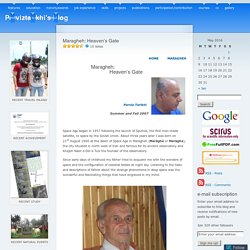
About three years later I was born on 21st August 1960 at the dawn of Space Age in Maragheh (Marāghé or Marāgha), the city situated in north west of Iran and famous for its ancient observatory and Khajeh Nasir a-Din-e Tusi the founder of the observatory. Since early days of childhood my father tried to acquaint me with the wonders of space and the configuration of celestial bodies at night sky. Listening to the talks and descriptions of father about the strange phenomena in deep space was the wonderful and fascinating things that have engraved in my mind. My father, Ahmad Tarikhi, played a key role in my interest and actuating me to space. (image credit: author) Father, basically a teacher at his young age, was banished to continue working following the coup d’etat of 1953 in Iran. Copernic De Revolutionibus. Le maître ouvrage du chanoine polonais a connu 5 éditions "historiques": l'editio princeps de 1543, une deuxième à Bâle en 1566, une troisième version "corrigée" en 1617 à Groningue (après la mise à l'Index de 1616 dans les pays catholiques), la quatrième à Varsovie en 1854, et enfin l'édition "de référence" de l'Académie de Varsovie en 1873, conforme au manuscrit original, retrouvé dans la bibliothèque Nostitz de Prague.

Sa présentation "grand public" est souvent limitée à ses préfaces et son premier livre, qui expose les principes généraux de son système. C'est là, sans doute, le plus important pour appréhender l'aspect philosophique, l'impact ultérieur et les remous engendrés (comme la condamnation de Galilée). Le reste est évacué sous prétexte d'être technique.
Technique, certes, cela l'est... pourrait-il en être autrement? Pour autant, on peut y pénétrer un peu plus avant, en regardant les figures. Préface(s): une prière, une dédicace... et un rajout. Al-Tusi. Même en ruines, l'observatoire impressionnera et inspirera fondamentalement un visiteur et grand astronome : Ulugh-Beg lui-même, qui tracera les plans de l'observatoire de Samarcande à partir de ceux de Maragheh.
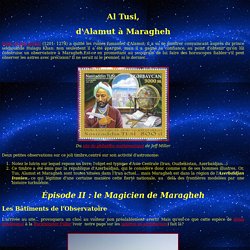
Il inspirera aussi le rsouverain Moghol Jaï-Shing, qui fera construire, toujours sur ce modèle, l'observatoire de Jaïpur. Celui-ci, fort bien conservé (promis, le Mathouriste vous en reparlera plus longuement un jour prochain...), donne une idée de l'aspect imposant des instruments de Maragheh.et Samarcande. Ce qu'on y fit Avec qui, et avec quels moyens.
Al-Tusi. Epicycloïde. ÉPICYCLOÏDEEpicycloid, Epizykloide Les épicycloïdes sont les courbes décrites par un point d'un cercle (C) roulant sans glisser sur un cercle de base (C0), les disques ouverts de frontières (C) et (C0) étant disjoints ; ce sont donc des cas particuliers d'épitrochoïdes.

Les épicycloïdes sont des courbes formées d'arcs isométriques (les arches) se rejoignant en des points de rebroussements (obtenus pour ) en nombre égal au numérateur du nombre q si q est rationnel et en nombre infini sinon.Lorsque q est rationnel, , la courbe est algébrique rationnelle (prendre comme paramètre ).Elle ressemble à un polygone régulier, croisé si m ³ 2, à n sommets joints de m en m par des courbes situées à l’extérieur du cercle (C0). Anti Antikythera. ⚡Présentation "Les catalogues astronomiques. Catalogues antiques détoiles Gan-Shi Xing Jing Chine - V e siècle av. J.C. des astronomes chinois Gan De et Shi Shen. Hipparque." The Institute for Research in Classical Philosophy and Science. Antiquity À-la-carte. The AWMC is proud to announce the release of a series of geographically accurate, publicly accessible map tiles ( ), suitable for use in nearly any web mapping application or GIS software suite.
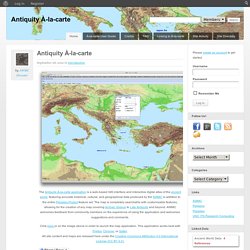
Links to Web-based Epigraphical Resources. This page is intended to provide a convenient starting point for exploring resources related to Greek and Latin epigraphy on the World Wide Web.

The list of links is large and therefore has been divided into sections (separate files) by category. Please email us with comments about the organization of these links. Links to resources are categorized as follows: Indexes to the links: There are now two specialized indexes to the links listings that we hope will make the ASGLE links pages easier to use. Editorial board The following uncompensated volunteers edit and maintain the information contained in the links portion of the ASGLE web site: Additional assistant editors are eagerly sought. EpiDig. Digital Epigraphy on the World-Wide Web — Institute for the Study of the Ancient World. Thanks to a gift from the Classics Conclave, ISAW has updated and expanded a public-domain bibliography of on-line resources for the discovery, publication, study, and teaching of epigraphy.
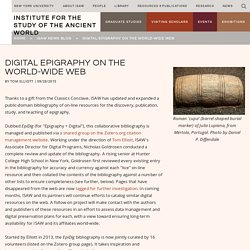
Dubbed EpiDig (for "Epigraphy + Digital"), this collaborative bibliography is managed and published via a shared group on the Zotero.org citation management website. Working under the direction of Tom Elliott, ISAW's Associate Director for Digital Programs, Nicholas Goldrosen conducted a complete review and update of the bibliography. A rising senior at Hunter College High School in New York, Goldrosen first reviewed every existing entry in the bibliography for accuracy and currency against each "live" on-line resource and then collated the contents of the bibliography against a number of other lists to ensure completeness (see further, below). Pages that have disappeared from the web are now tagged for further investigation. Pleiades.stoa.org. Pleiades Receives Major Grant — Institute for the Study of the Ancient World. At the end of July, the National Endowment for the Humanities announced the award of a $322,615 grant for major upgrades and improvements to the Pleiades gazetteer of ancient places.
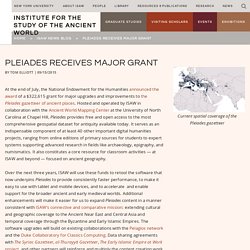
Hosted and operated by ISAW in collaboration with the Ancient World Mapping Center at the University of North Carolina at Chapel Hill, Pleiades provides free and open access to the most comprehensive geospatial dataset for antiquity available today. It serves as an indispensable component of at least 40 other important digital humanities projects, ranging from online editions of primary sources for students to expert systems supporting advanced research in fields like archaeology, epigraphy, and numismatics. It also constitutes a core resource for classroom activities — at ISAW and beyond — focused on ancient geography. Sciences, Philosophie, Histoire – UMR 7219, laboratoire SPHERE - Ibn al-Haytham. New Spherical Geometry and Astronomy. A History of Arabic Sciences and Mathematics, vol. 4 Roshdi Rashed This volume provides a unique primary source on the history and philosophy of mathematics and science from the mediaeval Arab world.
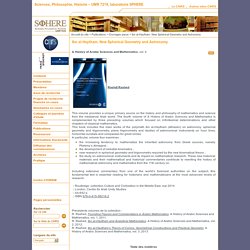
The fourth volume of A History of Arabic Sciences and Mathematics is complemented by three preceding volumes which focused on infinitesimal determinations and other chapters of classical mathematics. This book includes five main works of the polymath Ibn al-Haytham (Alhazen) on astronomy, spherical geometry and trigonometry, plane trigonometry and studies of astronomical instruments on hour lines, horizontal sundials and compasses for great circles. Including extensive commentary from one of the world’s foremost authorities on the subject, this fundamental text is essential reading for historians and mathematicians at the most advanced levels of research. Sciences, Philosophie, Histoire – UMR 7219, laboratoire SPHERE - Angles et grandeur.
From Antiquity until recently, philosophers and mathematicians have continually discussed the concept of angle and its relation to archimedean and non-archimedean theories of measurement.

For the first time, this book traces the history of these discussions in Greek and Arabic, from Euclid to Kamāl al-Dīn al-Fārisī, after whom the discussion was not resumed until Newton and Euler. The volume presents first editions of over twenty texts, either in Arabic or Greek and translated into Arabic, of the greatest mathematicians and philosophers of the time. The texts are here translated into French and supplemented with extensive commentary. UMR 8215 - Trajectoires - MATHIAS Florent. Doctorant - Université Paris 1 Panthéon-Sorbonne Contact : Florent.Mathias@malix.univ-paris1.fr. Galileo's Laboratory of Ideas. Galileo Galilei: Opere complete. Vol. 1. Firenze, 1842. Library of the Max Planck Insitute for the History of Science. Practical experience and applications—from glass manufacture to artillery—shaped Galileo Galilei’s thinking on physics. As a young mathematician, he dedicated himself to problems of mechanics.
“The other Galileo” Jürgen Renn in conversation with Thomas de Padova. Once in Padua, Galileo followed his patron’s example and set up a workshop. La mesure du monde : Eratosthène et Ptolémée - département d'ethnologie et d'anthropologie de l'université de la Réunion. Chapitre 18. Chaldea. SEAC2015. Search Home Venue Program Abstract submission and proceedings Registration Scientific Committee Hotels and tours Sponsors Astronomy in Past and Present Cultures. Early Chinese Daybooks and the Question of Textual Genre. Bibliographie_anticythere.pdf.
Enseignement 2014-2015 — Voir/Savoir : images et cultures visuelles dans les sciences. Charlotte Bigg, chargée de recherche au CNRS Cet enseignant est référent pour cette UE S'il s'agit de l'enseignement principal d'un enseignant, le nom de celui-ci est indiqué en gras. Jeudi de 14 h à 17 h (Centre Alexandre-Koyré, 27 rue Damesme (5e étage) 75013 Paris), les 13 novembre 2014, 18 décembre, 15 janvier, 12 février, 12 mars, 16 avril, 21 mai et 11 juin 2015 Ce séminaire propose une introduction aux études visuelles des sciences, un champ qui a émergé ces dernières années en partie pour faire face aux interrogations épistémologiques posées par la place croissante de l’image dans la production et la communication scientifiques contemporaines : nouvelles technologies de visualisation, présence croissante d’images, de modèles et de simulations dans l’enseignement et la recherche, la communication et la muséologie.
Programme : 13 novembre 2014: Séance d’introduction 18 décembre 2014 : Observer et lire à la Renaissance 15 janvier 2015 : La médiatisation des sciences par le film. Cosmic Journey: A History of Scientific Cosmology. Histoire cosmo. Learn about Jim Robertson's Solar and Lunar Orrery.
Histoire des sciences fredericchaberlot.ch. La science et ses applications ont radicalement transformé le paysage de nos sociétés. Son pouvoir en a fait un objet de fantasmes tel que nous projetons sur elle nos peurs et nos espoirs.